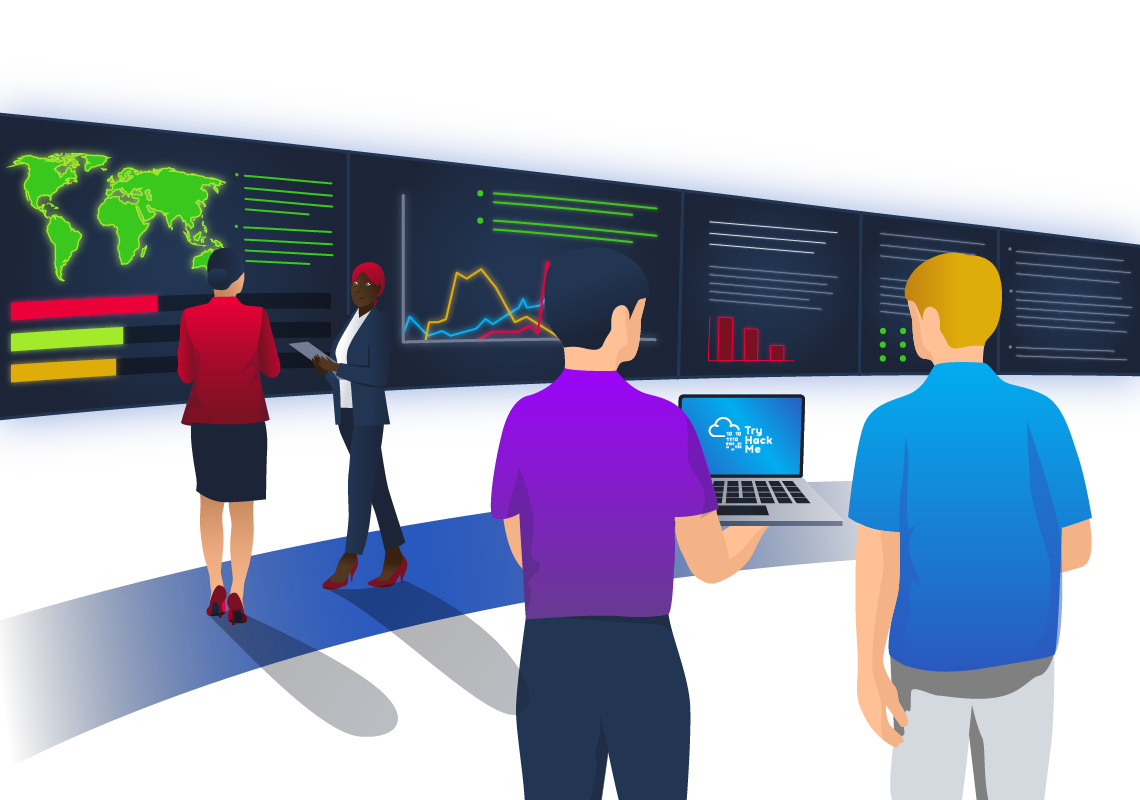To access material, start machines and answer questions login.
Network Security is a set of operations for protecting data, applications, devices and systems connected to the network. It is accepted as one of the significant subdomains of cyber security. It focuses on the system design, operation and management of the architecture/infrastructure to provide network accessibility, integrity, continuity and reliability. Traffic analysis (often called Network Traffic Analysis) is a subdomain of the Network Security domain, and its primary focus is investigating the network data to identify problems and anomalies.
This room will cover the foundations of Network Security and Traffic analysis and introduce the essential concepts of these disciplines to help you step into Traffic/Packet Analysis. We suggest completing the "Network Fundamentals module before starting working in this room.

Network Security
The essential concern of Network Security focuses on two core concepts: authentication and authorisation. There are a variety of tools, technologies, and approaches to ensure and measure implementations of these two key concepts and go beyond to provide continuity and reliability. Network security operations contain three base control levels to ensure the maximum available security management.
Base Network Security Control Levels:
| Physical | Physical security controls prevent unauthorised physical access to networking devices, cable boards, locks, and all linked components. |
| Technical | Data security controls prevent unauthorised access to network data, like installing tunnels and implementing security layers. |
| Administrative | Administrative security controls provide consistency in security operations like creating policies, access levels and authentication processes. |
There are two main approaches and multiple elements under these control levels. The most common elements used in network security operations are explained below.
The main approaches:
| Access Control | Threat Control |
| The starting point of Network Security. It is a set of controls to ensure authentication and authorisation. |
Detecting and preventing anomalous/malicious activities on the network. It contains both internal (trusted) and external traffic data probes. |
The key elements of Access Control:
| Firewall Protection |
Controls incoming and outgoing network traffic with predetermined security rules. Designed to block suspicious/malicious traffic and application-layer threats while allowing legitimate and expected traffic. |
| Network Access Control (NAC) |
Controls the devices' suitability before access to the network. Designed to verify device specifications and conditions are compliant with the predetermined profile before connecting to the network. |
| Identity and Access Management (IAM) | Controls and manages the asset identities and user access to data systems and resources over the network. |
| Load Balancing | Controls the resource usage to distribute (based on metrics) tasks over a set of resources and improve overall data processing flow. |
| Network Segmentation |
Creates and controls network ranges and segmentation to isolate the users' access levels, group assets with common functionalities, and improve the protection of sensitive/internal devices/data in a safer network. |
| Virtual Private Networks (VPN) |
Creates and controls encrypted communication between devices (typically for secure remote access) over the network (including communications over the internet). |
| Zero Trust Model | Suggests configuring and implementing the access and permissions at a minimum level (providing access required to fulfil the assigned role). The mindset is focused on: "Never trust, always verify". |
The key elements of Threat Control:
| Intrusion Detection and Prevention (IDS/IPS) |
Inspects the traffic and creates alerts (IDS) or resets the connection (IPS) when detecting an anomaly/threat. |
| Data Loss Prevention (DLP) |
Inspects the traffic (performs content inspection and contextual analysis of the data on the wire) and blocks the extraction of sensitive data. |
| Endpoint Protection |
Protecting all kinds of endpoints and appliances that connect to the network by using a multi-layered approach like encryption, antivirus, antimalware, DLP, and IDS/IPS. |
| Cloud Security | Protecting cloud/online-based systems resources from threats and data leakage by applying suitable countermeasures like VPN and data encryption. |
| Security Information and Event Management (SIEM) |
Technology that helps threat detection, compliance, and security incident management, through available data (logs and traffic statistics) by using event and context analysis to identify anomalies, threats, and vulnerabilities. |
| Security Orchestration Automation and Response (SOAR) |
Technology that helps coordinate and automates tasks between various people, tools, and data within a single platform to identify anomalies, threats, and vulnerabilities. It also supports vulnerability management, incident response, and security operations. |
| Network Traffic Analysis & Network Detection and Response | Inspecting network traffic or traffic capture to identify anomalies and threats. |
Typical Network Security Management Operation is explained in the given table:
| Deployment | Configuration | Management | Monitoring | Maintenance |
|
|
|
|
|
Managed Security Services
Not every organisation has enough resources to create dedicated groups for specific security domains. There are plenty of reasons for this: budget, employee skillset, and organisation size could determine how security operations are handled. At this point, Managed Security Services (MSS) come up to fulfil the required effort to ensure/enhance security needs. MSS are services that have been outsourced to service providers. These service providers are called Managed Security Service Providers (MSSPs). Today, most MSS are time and cost effective, can be conducted in-house or outsourced, are easy to engage, and ease the management process. There are various elements of MSS, and the most common ones are explained below.
| Network Penetration Testing | Assessing network security by simulating external/internal attacker techniques to breach the network. |
| Vulnerability Assessment | Assessing network security by discovering and analysing vulnerabilities in the environment. |
| Incident Response |
An organised approach to addressing and managing a security breach. It contains a set of actions to identify, contain, and eliminate incidents. |
| Behavioural Analysis | An organised approach to addressing system and user behaviours, creating baselines and traffic profiles for specific patterns to detect anomalies, threats, vulnerabilities, and attacks. |
Which Access Control element works with data metrics to manage data flow?
Which technology helps correlate different tool outputs and data sources?

Traffic Analysis / Network Traffic Analysis
Traffic Analysis is a method of intercepting, recording/monitoring, and analysing network data and communication patterns to detect and respond to system health issues, network anomalies, and threats. The network is a rich data source, so traffic analysis is useful for security and operational matters. The operational issues cover system availability checks and measuring performance, and the security issues cover anomaly and suspicious activity detection on the network.
Traffic analysis is one of the essential approaches used in network security, and it is part of multiple disciplines of network security operations listed below:
- Network Sniffing and Packet Analysis (Covered in Wireshark room)
- Network Monitoring (Covered in Zeek room)
- Intrusion Detection and Prevention (Covered in Snort room)
- Network Forensics (Covered in NetworkMiner room)
- Threat Hunting (Covered in Brim room)
There are two main techniques used in Traffic Analysis:
| Flow Analysis | Packet Analysis |
|
Collecting data/evidence from the networking devices. This type of analysis aims to provide statistical results through the data summary without applying in-depth packet-level investigation.
|
Collecting all available network data. Applying in-depth packet-level investigation (often called Deep Packet Inspection (DPI) ) to detect and block anomalous and malicious packets.
|
Benefits of the Traffic Analysis:
- Provides full network visibility.
- Helps comprehensive baselining for asset tracking.
- Helps to detect/respond to anomalies and threats.
Does the Traffic Analysis Still Matter?
The widespread usage of security tools/services and an increasing shift to cloud computing force attackers to modify their tactics and techniques to avoid detection. Network data is a pure and rich data source. Even if it is encoded/encrypted, it still provides a value by pointing to an odd, weird or unexpected pattern/situation. Therefore traffic analysis is still a must-to-have skill for any security analyst who wants to detect and respond to advanced threats.
Now you know what Traffic Analysis is and how it operates. Now use the static site to simulate a traffic analysis operation and find the flags.
Level-1 is simulating the identification and filtering of malicious IP addresses.
What is the flag?
Level-2 is simulating the identification and filtering of malicious IP and Port addresses.
What is the flag?
Congratulations! You just finished the "Traffic Analysis Essentials" room.
In this room, we covered the foundations of the network security and traffic analysis concepts:
- Network Security Operations
- Network Traffic Analysis
Now, you are ready to complete the "Network Security and Traffic Analysis" module.
Ready to learn Cyber Security? Create your free account today!
TryHackMe provides free online cyber security training to secure jobs & upskill through a fun, interactive learning environment.
Already have an account? Log in
